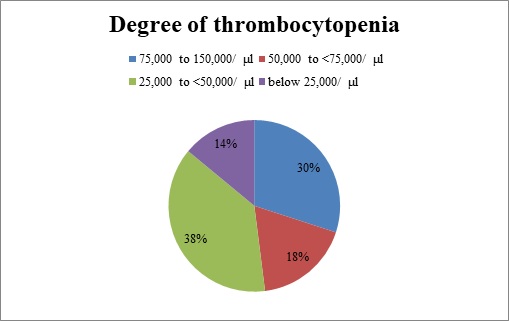Evaluation of markers of thrombosis and fibrinolysis in malaria patients in tertiary care hospital in Central India
Abstract
Background: Cases of malaria are known to be associated with variable degrees of coagulopathy as evident from abnormalities of screening coagulation assays in a large number of patients during the illness. However, attempts to use laboratory parameters as indicators of the severity of the underlying coagulopathy and for monitoring disease progression have met with only partial success.
Methods: This prospective study was conducted in the department of Pathology in Ruxmaniben Deepchand Gardi Medical College, Ujjain. Blood samples of all the patients diagnosed positive with malaria were collected in vials containing ethylene tetra-acetic acid tri potassium salt for hematological parameters and in trisodium citrate tubes for coagulation assays.
Result: Out of the total positive cases, PT was prolonged in 65% of total cases, Percentage positivity for prolonged PT for falciparum and vivax is 60% and 68.5% respectively. APTT has raised 47% of malaria positive cases with percentage positivity for falciparum and vivax 48% and 45.7% respectively. 55% of total cases showed raised levels of fibrin degradation products, which included 48% of falciparum cases and 60% of vivax cases. Out of 120 positive cases of malaria, D- Dimer was raised 41.7% cases.
Conclusion: As blood is the chief component affected by malaria, not only proper examination of peripheral smears is required for detection and species identification, but a careful evaluation of other laboratory parameters should be done irrespective of the malarial species for the early diagnosis of compensatory and non-compensatory consumptive coagulopathy.
Downloads
References
Haemostasis and Thrombosis: Basic Principles and Clinical Practice, 3rd Edition, Edited by R.W. Colman. Jack Hirsh, Victor J. Marder, and Edwin W. Salzman, J.B. Lippincott Company, 1994;1197-1206.
Kenneth J, Arrow, Claire B. Panosian and Hellen Gelband, Chloroquine and quinine-, institute of medicine of the national academics.
CRC, Handbook Series in Clinical Laboratory, Science, Section 1: Haematology, Volume III, 1980. CRC Press, Inc. Boca, Raton Florida.
Mohan K, Shruthi A. Clinical, hematological and coagulation proflile in malaria. Sch J Appl Med Sci. 2014;2(2B):584-588.
Kini Reshma G, Lobo Veronica, Lyngdoh Raphael H, MsVedasree R. Clinical Correlation of Coagulopathy in Vivax Malaria, Published by Pacific Group of e-Journals (PaGe), AABS3 (1),2016.
Das HS, Study of clinical and laboratory profile in malaria. Indian J App Res. 2015;5(12):218-222.
Sharma SK, Das RK, Das BK, Das PK: Haematological and coagulation profile in acute falciparum malaria. J Assoc Physicians India 1992,40:581-583.
Mohapatra S, Samantaray JC, Arulselvi S, Ghosh A. Disseminated intravascular coagulation following malaria due to Plasmodium vivax: A thromboelastography-based study. Malar J. 2013;12:336. doi: 10.1186/1475-2875-12-336.
Srivastava S, Ahmad S, Shirazi N, Kumar Verma S, Puri P. Retrospective analysis of vivax malaria patients presenting to tertiary referral centre of Uttarakhand. Acta Trop. 2011;117(2):82-85. doi: 10.1016/j.actatropica.2010.10.001.
Prasad R, Das BK, Pengoria R, Mishra OP, Shukla J, Singh TB. Coagulation Status and Platelet Functions in Children with Severe Falciparum Malaria and their Correlation of Outcome. J Trop Pediatr. 2009;55(1):374-378. doi: 10.1093/tropej/fmp028.
Datta S, Roul LD, Das S, Panda JK, Pattanayak NC. A study of the coagulation profile in falciparum malaria, Orissa physicians journal OPJ. 2011;;7:13-17.
Sahoo AK, Das KK. Coagulation profile in severe falciparum malaria and its clinical correlation. Int J Gen Med Pharmacy. 2013;2(1):9-14.
Dasgupta A, Rai S, Das Gupta A. Persistently Elevated Laboratory Markers of Thrombosis and Fibrinolysis After Clinical Recovery in Malaria Points to Residual and Smouldering Cellular Damage. Indian J Hematol Blood Transfus. 2012;28(1):29-36. doi: 10.1007/s12288-011-0106-y.
Ladhani S, Lowe B, Cole AO, Kowuondo K, Newton CR. Changes in white blood cells and platelets in children with falciparum malaria: relationship to disease outcome. Brit J Haematol. 2002;119(3):839-847. doi: 10.1046/j.1365-2141.2002.03904.x.
Misra DP, Das S, Pattnaik M, Singh SC, Jena RK. Relationship of hepatic and renal dysfunction with haemorrheological parameters in Plasmodium falciparum malaria. J Assoc Physicians India. 2011;59:552-556.

Copyright (c) 2021 Author (s). Published by Siddharth Health Research and Social Welfare Society

This work is licensed under a Creative Commons Attribution 4.0 International License.


 OAI - Open Archives Initiative
OAI - Open Archives Initiative


